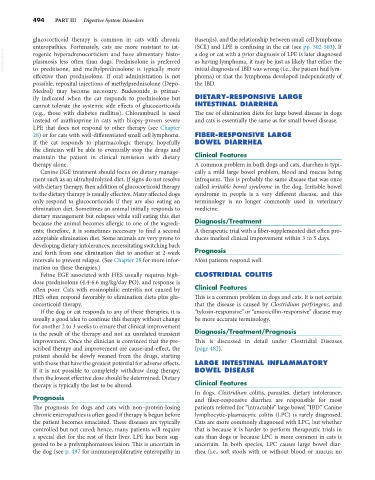Page 522 - Small Animal Internal Medicine, 6th Edition
P. 522
494 PART III Digestive System Disorders
glucocorticoid therapy is common in cats with chronic Basenjis), and the relationship between small cell lymphoma
enteropathies. Fortunately, cats are more resistant to iat- (SCL) and LPE is confusing in the cat (see pp. 502-503). If
VetBooks.ir rogenic hyperadrenocorticism and have alimentary histo- a dog or cat with a prior diagnosis of LPE is later diagnosed
as having lymphoma, it may be just as likely that either the
plasmosis less often than dogs. Prednisolone is preferred
to prednisone, and methylprednisolone is typically more
phoma) or that the lymphoma developed independently of
effective than prednisolone. If oral administration is not initial diagnosis of IBD was wrong (i.e., the patient had lym-
possible, reposital injections of methylprednisolone (Depo- the IBD.
Medrol) may become necessary. Budesonide is primar-
ily indicated when the cat responds to prednisolone but DIETARY-RESPONSIVE LARGE
cannot tolerate the systemic side effects of glucocorticoids INTESTINAL DIARRHEA
(e.g., those with diabetes mellitus). Chlorambucil is used The use of elimination diets for large bowel disease in dogs
instead of azathioprine in cats with biopsy-proven severe and cats is essentially the same as for small bowel disease.
LPE that does not respond to other therapy (see Chapter
28) or for cats with well-differentiated small cell lymphoma. FIBER-RESPONSIVE LARGE
If the cat responds to pharmacologic therapy, hopefully BOWEL DIARRHEA
the clinician will be able to eventually stop the drugs and
maintain the patient in clinical remission with dietary Clinical Features
therapy alone. A common problem in both dogs and cats, diarrhea is typi-
Canine EGE treatment should focus on dietary manage- cally a mild large bowel problem, blood and mucus being
ment such as an ultrahydrolyzed diet. If signs do not resolve infrequent. This is probably the same disease that was once
with dietary therapy, then addition of glucocorticoid therapy called irritable bowel syndrome in the dog. Irritable bowel
to the dietary therapy is usually effective. Many affected dogs syndrome in people is a very different disease, and this
only respond to glucocorticoids if they are also eating an terminology is no longer commonly used in veterinary
elimination diet. Sometimes an animal initially responds to medicine.
dietary management but relapses while still eating this diet
because the animal becomes allergic to one of the ingredi- Diagnosis/Treatment
ents; therefore, it is sometimes necessary to find a second A therapeutic trial with a fiber-supplemented diet often pro-
acceptable elimination diet. Some animals are very prone to duces marked clinical improvement within 3 to 5 days.
developing dietary intolerances, necessitating switching back
and forth from one elimination diet to another at 2-week Prognosis
intervals to prevent relapse. (See Chapter 28 for more infor- Most patients respond well.
mation on these therapies.)
Feline EGE associated with HES usually requires high- CLOSTRIDIAL COLITIS
dose prednisolone (4.4-6.6 mg/kg/day PO), and response is
often poor. Cats with eosinophilic enteritis not caused by Clinical Features
HES often respond favorably to elimination diets plus glu- This is a common problem in dogs and cats. It is not certain
cocorticoid therapy. that the disease is caused by Clostridium perfringens, and
If the dog or cat responds to any of these therapies, it is “tylosin-responsive” or “amoxicillin-responsive” disease may
usually a good idea to continue this therapy without change be more accurate terminology.
for another 2 to 3 weeks to ensure that clinical improvement
is the result of the therapy and not an unrelated transient Diagnosis/Treatment/Prognosis
improvement. Once the clinician is convinced that the pre- This is discussed in detail under Clostridial Diseases
scribed therapy and improvement are cause-and-effect, the (page 482).
patient should be slowly weaned from the drugs, starting
with those that have the greatest potential for adverse effects. LARGE INTESTINAL INFLAMMATORY
If it is not possible to completely withdraw drug therapy, BOWEL DISEASE
then the lowest effective dose should be determined. Dietary
therapy is typically the last to be altered. Clinical Features
In dogs, Clostridium colitis, parasites, dietary intolerance,
Prognosis and fiber-responsive diarrhea are responsible for most
The prognosis for dogs and cats with non–protein-losing patients referred for “intractable” large bowel “IBD.” Canine
chronic enteropathies is often good if therapy is begun before lymphocytic-plasmacytic colitis (LPC) is rarely diagnosed.
the patient becomes emaciated. These diseases are typically Cats are more commonly diagnosed with LPC, but whether
controlled but not cured; hence, many patients will require that is because it is harder to perform therapeutic trials in
a special diet for the rest of their lives. LPE has been sug- cats than dogs or because LPC is more common in cats is
gested to be a prelymphomatous lesion. This is uncertain in uncertain. In both species, LPC causes large bowel diar-
the dog (see p. 497 for immunoproliferative enteropathy in rhea (i.e., soft stools with or without blood or mucus; no

